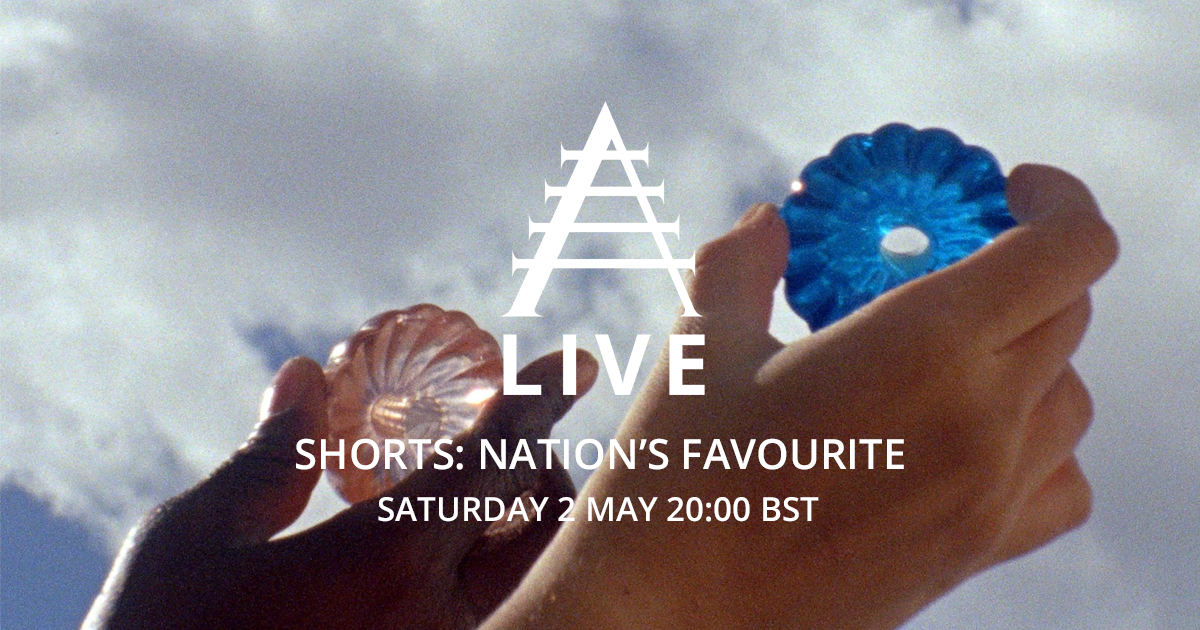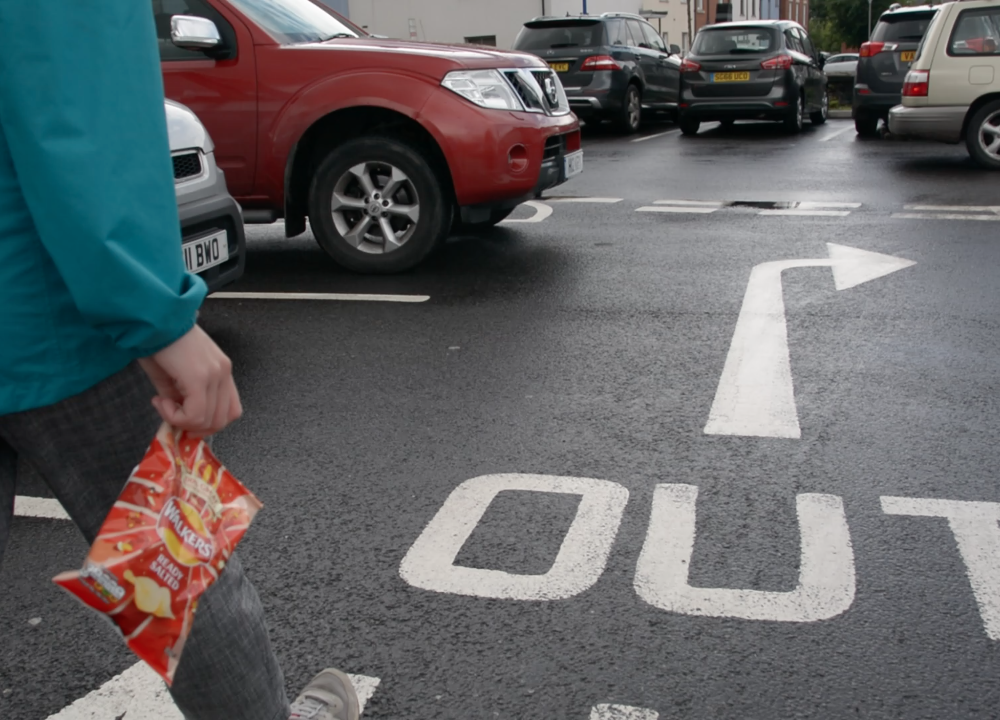Alchemy Film & Arts
Using film as a way to come together, have conversations and strengthen community.
SHORTS: NATION'S FAVOURITE
SATURDAY 2 MAY
20:00 – 21:00 BST
Watch the programme HERE. All programmes begin at their advertised time.

PROGRAMME NOTES
by Rachael Disbury
From Scotch mist and British tatties to the interplay between conspiracy and culture, the seven films in Nation’s Favourite unearth, question and reframe authenticities of place, tourism and national identity.
In Seán Martin’s Koan IV, an opening provocation suggests that the things we see continually hide the things we’d like to see. What we see after this is mist in a Scottish landscape. Martin’s patient, enigmatic film contemplates a popular image of romance and intrigue attributed to a rural identity, alluding to what is hidden, what is real and what does not exist.
In Eat British Potatoes Again, Sophie Lindsey explores nationhood through the nation’s favourite snack, Walkers Ready Salted crisps. Lindsey spotlights the soundscape of a British supermarket, the nostalgic boast of ‘100% Great British Potatoes’, and the links between identity, Britishness and consumerism – with a delightfully wry final ritual.
Felicity E. Palma’s Medusa and The Abyss meditates on female rite and ritual, using prisms, water and 16mm film to obscure notions of landscape, monument, history and myth in touristic Sicily. Such an exposing portrait questions the ways in which cultural identities are commanded and cultivated by people, nations and policy. In A Wilderness of Lost Connections, Dana Venezia juxtaposes three distinct belief systems and the convictions of these disparate systems from the perspectives and rituals of three sets of male protagonists, creating the identity of the film’s macro-protagonist, America.
To All Those is a symphony by Josh Weissbach capturing a city from the perspective of commuter-dreamers, and all that unfolds in lone untethered thought. Through ambient sound and the slow textured images of an American cityscape, Weissbach creates a non-place, a site and rhythm that communicates the freedom of movement and practical pleasure of travel itself. Lin Li’s waterscapes in I am so tired reject any notion of safety or comfort in their stormy aggression, with excerpts from BBC news recordings creating a thick and fearful sensory nightmare of displacement.
In the Last Were Buried Here, Annette Philo returns us to the Scottish landscape and its associated dream-like mystique. With gentle overlays, vivid purples and blues, and alluding to the hidden graves of the last of the Knights Templar, Philo’s depiction of bluebell island lulls us into a contemplation on the duality of what we see for ourselves, and what is cultivated as cultural, historical and national identity.

KOAN IV
Seán Martin – 6’49 – UK
World Premiere

EAT BRITISH POTATOES AGAIN
Sophie Lindsey – 3’45 – UK
World Premiere

MEDUSA AND THE ABYSS
Felicity E. Palma – 10’57 – Italy / USA
International Premiere

A WILDERNESS OF LOST CONNECTIONS
Dana Venezia – 12’47 – USA
International Premiere

TO ALL THOSE
Josh Weissbach – 6’25 – USA
European Premiere

‘I AM SO TIRED’
Lin Li – 2’30 – UK
World Premiere

THE LAST WERE BURIED HERE
Annette Philo – 10’50 – UK
World Premiere
ARTIST Q&As
Alchemy asks…
Seán Martin, Koan IV
Koan IV is a rather enigmatic contemplation of landscape. It’s very patient – as if looking at this place for long enough will provoke its identity to be revealed.
My interest in the koan comes from my interest in Zen. The student is encouraged to contemplate the koan until rational or logical thinking breaks down. Zen strikes me as a system of teachings full of paradox – simple yet complicated, obvious yet hidden. It reminds me of the way in which filmmakers like Abbas Kiarostami made their films. By leaving so much out, the viewer is forced to participate to become effectively a co-creator. One thinks of Five, or Shirin. This isn’t laziness on Kiarostami’s part, but a practice informed by the conviction that the viewer has to be active, has to contribute something to the film. In this way, the image becomes part of the viewer’s life. Zen students are encouraged to live with the koan they are studying, and in a similar way, a film can form part of one’s life. It is not content to be consumed, but an experience to be lived.
Koan IV came about by chance. I had already made three films in the series, and knew that there would be others. While staying on Jura, I went out for a walk one day and saw the Paps covered in fog. I ran back to the house and got my camera. The film I was making there was for an installation, but as soon as I had mountain and mist in my viewfinder, I realised that this footage would work well in the Koan series. As each film begins with an onscreen epigraph, the key to making a film like this is finding the right match for image and text. I already knew of Magritte’s comment that ‘everything we see hides another thing’, so that presented itself to me almost immediately. Magritte seems to be implying something similar to Kiarostami, that the image by itself is only the starting point.
You’ve managed very well to defamiliarize place here. This is a Scottish landscape, but the mist, the framing and the texture could also evoke more far-flung climes.
The footage seemed to reinforce the choice of the Magritte quote. The mist was obscuring the mountain to such an extent that I could no longer see it by the time I finished shooting. Mist, fog, haar – whatever you call it, it has the same effect, of defamiliarizing the world. Perhaps for this reason it’s possibly my favourite kind of weather. We could also say it departicularises a landscape. Although I was shooting on Jura, Koan IV could be anywhere, the precise location is not important – because, as Magritte reminds us, ‘everything we see hides another thing.’
Sophie Lindsey, Eat British Potatoes Again
This film documents a simple enough action – you walk into a supermarket, buy a packet of crisps, eat the crisps, and hoist the packet onto a makeshift flagpole. But there are more complex issues at play: nationhood, branding, the production of consumer goods.
This performance to camera grew out of an ongoing research project exploring the different ways the rural is portrayed within urban environments. I was particularly interested in how aesthetic priorities continue to contribute to our collective imagination, and while traditionally this was communicated through landscape painting, today our ideas of the countryside are often expressed through what we buy and consume.
In the supermarket, phrases like ‘freshly picked’ or ‘locally grown’ are a common marketing strategy for quality assurance, but when this language becomes paired with imagery of flags this also contributes to a sense of national identity. While today, there are more urgent concerns and changes that have taken place in the supermarket, this time last year the volume of British flags on produce was the daily backdrop to the divisive dialogue of Brexit negotiations. While these were probably conceived as a way to reassure shoppers that certain products will still be available once leaving the European Union, I felt the prevalence of the Union Jack seemed to be skirting quite close to more negative expressions of nationalism.
The re-branded Walkers crisp packet was one of the most exaggerated depictions of this, with the abstract Union Jack, flanked by digital illustrations of Big Ben, a cup of tea, tractors, old phone booths, and for some reason a squirrel with a bowler hat and a monocle. By acting out the new function of this empty packet as a flag, I sought to engage with the absurdity of this object, and question how we relate to everyday expressions of nationalism.
Thinking about place and authenticity, to what extent might the range of consumables produced for a particular market – in this instance, Ready Salted crisps produced for a British market – tell us about a place?
I always enjoy going to supermarkets wherever I am. When you are out of your regular routine, they can often feel uncanny as universal goods appear in a different order, and alternative brands or products are available. While this is more noticeable in different countries, including in the context of Britain, where there is significantly more Irn Bru in Scotland, and Welsh cakes in Wales, there are smaller regional differences that reflect the dominant buying habits of the area.
These habits can contribute to our understanding of place, but we can also widen this lens to consider what my selection of Ready Salted Walkers crisps can tell us about of the lunch habits of the nation.
The crisp packet I selected is notable when you consider all the other options available in this particular Morrisons. Rather than a family-sized multipack or a large sharing bag, I selected a single, individually sold packet. While mainly for practical reasons, and for the simplicity of the piece, this brings lunch habits into the work, as this packet is located alongside the packaged sandwiches and form part of the meal deal. This deal, where you select three items, usually a sandwich, crisps, fruit or drink, is available in countless shops and supermarkets and has become a shorthand for lunch choices on the go.
This simple three-element lunch, and its manufactured sandwiches, shows we are retaining the eating habits we developed as children, as they are reminiscent of the packed lunches made by our parents. By relying on these ready-mades, we are showing that as a nation we are prioritising convenience over nutrition and socialisation, as this eliminates the need for a longer sit-down meal.
Crisps are a crucial element of this, as I don’t believe we would tolerate unsatisfying sandwiches, if we couldn’t follow it with a packet of crisps. Writing this now, I wonder about the current sale of pre-packaged sandwiches, and whether our lunch choices are becoming more than an afterthought now we are in lockdown.
Dana Venezia, A Wilderness of Lost Connections
Your film teases at a narrative thread between its disparate subjects, but ultimately resists linking them outright. It leaves much room for the viewer to do the work – the overall picture of this locale lies as much in the ellipses between scenes as in their actual content.
The film is tied together by the ambiguity of the characters, the setting and the eerie atmosphere. The connections between the scenes are associational and link the different parts in the same absurdity I encountered in reality. The individuals portrayed in the film were all neighbours in a small rural town in Vermont but could not be more different and the relationships between them stretch far from common ideology or belief. The lack of substantial connection between them is what brought me to find these common threads through the editing process. In a space that is not as defined, I found things can actually fit together.
There’s a temptation to tie a snapshot like this to some bigger picture – to see in the finer details some evidence of nationhood. Was this something you tried to resist in making the film, or might we view this as an avatar for the USA as a whole?
I tried to give a sense of a place that is very particular up to a point that its inherent specificity can be abstracted into anywhere. A place that is remote and unknown – somewhere, nowhere, anywhere. A reality negotiating utopia and dystopia, a place between the ether and the abyss. The film zooms in on a small town but represents the deep complexity that lies within American mythology and reflects onto its present-day status.
Josh Weissbach, To All Those
To all those what, exactly?
The title of this film has an interesting history. I use the word history because the first version of this film was made in 2006. At that time, my collaborators and I were having a very difficult time coming up with a title. Eventually, Ben Balcom – who has also exhibited work at past editions of Alchemy – came up with the title To All Those Who Have Been There Before. This title was inspired by one of the first shots of the film’s closing sequence as the camera moves below ground with the train or subway commuters. In one of those shots, you can briefly read the sign To All Trains.
Since the completion of this original version, I have always turned the original title into a shorthand in my head – To All Those – and felt that while making this new version, that this new title was more inclusive, subtle, open-minded, less literal, and was less rooted in a sense of time. With all of that said, I think to answer your question more explicitly, I would say that the original idea of the title still remains for me in this new version, even if it is less apparent to a viewer. To All Those references the inhabitants of the film. The workers. The wanderers. The waiters. And to all of the other descriptors that I could use for them, which are numerous. I also think the synopsis, written by Ben Balcom, provides some lovely insight: ‘a city symphony in miniature, dedicated to anyone who has gotten lost in thought while stuck on the midwinter train. to all that unfolds in those private reveries.’
Your film has the feel of a wanderer, a drifter. Notions of place seem very tied here to the sights – and sites – one encounters on a commute, a lunch break…
I love that you are engaging in the sights/sites duality. Because so much of my work is dedicated to place, space, landscape, I think the meanings of these different and simultaneous words is very important to think about. One could make the argument that no film about place, space, landscape is totally about a site, but is simply a collection of sights. But that also might be me engaging in semantics more than I usually like to.
I will say I do not know if I ever really think of the perspective of the camera as that of wanderer or drifter, but maybe more as a displaced observer, removed but still attached. Because this film was shot in the Loop in downtown Chicago, movement of human bodies during the day and entering the rush hour period is quite dense. All of these bodies belong to a single, solitary, and continuous mass, but are always separate from each other in thought, in reverie, in a sense of wonder and that is something that one could personally encounter while in this phenomenon of banality and within this miniature city symphony.
Lin Li, ‘I am so tired’
The sea is one of the great versatile characters of drama, literature, cinema. In your film, it’s violent, aggressive, changeable. How did you arrive at this particular footage?
What I try to express in ‘I am so tired’ is the emotional impact of the news reports in recent years about migrants who have escaped their homeland by boats. I cannot even begin to imagine how these refugees would feel as they drift along in the changeable, potentially violent and dangerous sea. The imagery expresses the overwhelming emotions which I find difficult to describe in words, but the choppy rise and fall of the waves in their increasingly intense colours seems to be able to convey the complex web of feelings I have experienced when listening to such news. Part of the wave footage in ‘I am so tired’ has been used in an earlier video I made, and is I think even more appropriate to the theme of the present work. The original wave footage was captured from a ferry during a rather rough crossing to an island. It was combined with a watercolour painting I had done to create the changing colours.
Thinking of place, of nationhood, of belonging… what kinds of testimonies are we hearing here, and how important was it that you kept the testimonies to snippets rather than full quotes?
The audio and text are extracted from BBC news reports. I have only used snippets rather than full quotes because I assume many viewers would be familiar with the refugee crisis in Europe this century, caused largely by violence and conflict such as the war in Syria. My concern is also more universal than geopolitically specific. Certain words in these reports stick out as they conjure a visceral imagination in me due to their physicality or repeated use by different journalists. Although the news items I used were about specific places and events, similar stories have happened, and sadly will continue to happen, in many parts of the world and at different times. My own emotional reaction has been influenced by the fact that my maternal grandparents and their family members drowned when they tried to flee China by sea many decades ago. A different place, a different history, but the same kind of tragedy which the human race seems to be incapable of avoiding.
Annette Philo, The Last Were Buried Here
There are two continuous takes layered here. Did you shoot each of them with the other in mind, and what was it about this place that you were trying to capture?
I think it’s relevant to say my background as a painter underpins the manner of my editing, which is not by cuts but by colour grading and selection. My films are made out of continuous takes, either moving or static. Most of the sound is recorded on location which is then integrated with the images as they come into their own.
With The Last Were Buried Here I had meant to edit in a more traditional cut but for a filmmaker who likes to stick with one continuous take, old habits die hard. On my return to London I combed through 5½ terabytes of material, I was still very close to the experience of travelling alone in a boat to this remote location, enduring the changing weather Scotland enjoys. However, out of all the material, the two central ten-minute takes and the soundtrack recorded mostly around Loch Awe hold the essence of this place, the remnants of its history and the island as it exists today.
Not much happens in this place, and yet it seems full of potential – as if anything which has happened could happen again, or indeed is still happening.
In the past I have made longer-form films that present events over time. As I move from presenting my films in a gallery space into a single projection space, I have worked on how I can present a constantly engaging surface which keeps the attention of the static audience.
In my last film White Point, the frame was static but I dialled the exposure in and out. With The Last were Buried Here, I adopted the momentum of continually moving shots which locks the viewer into engagement. It also provides the collision of images between the layers which gives rise to events. While these events are only given rise to out of the coincidence of timing, they belong to one another within the film’s construction. Separate and together the images homogenise, the human eye goes between the two as they collide.
The two ten-minute shots were made on separate days. After having established possible shots in the graveyard, on the second day I was looking for opportunities that might open onto the darker enclosed image. When I filmed the bluebell layer, I knew that focusing on the close shot of the bluebells would create what photographers call bokeh – a soft blur – of the dying vegetation in the distance. I knew this bokeh can then be worked upon through the colour grading process, to enhance or evaporate parts of the image. However, when shooting terabytes of material in an environment that offers up so many opportunities, I am looking for what could work, depending on what the light conditions the weather offers me.
Alchemy Film & Arts
Room 305
Heart of Hawick
Hawick
TD9 0AE
info@alchemyfilmandarts.org.uk
01450 367 352
Charity Number: SC042142


© 2025 Alchemy Film & Arts